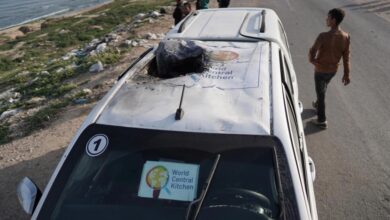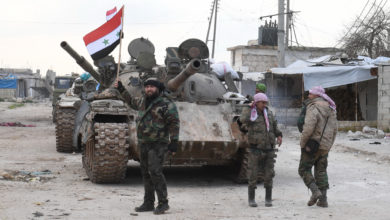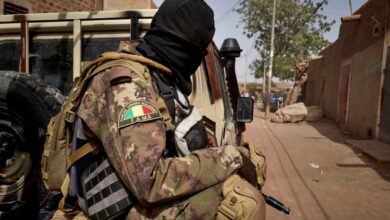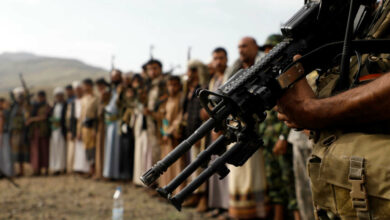Climate change: an increasingly dangerous recruiting sergeant for insurgent groups
Extreme weather conditions due to climate change are enabling armed groups to more-easily recruit members and control populations
As the Trump administration continues to question climate change, temperature measured in the polar regions is breaking records.
At the moment, the Arctic system is “trending away from its 20th Century state and into an unprecedented state,” and implications of this shift will be felt far beyond, according to the latest report produced by U.S. and European climate scientists published last week.
“Because the Arctic atmosphere is warming faster than the rest of the world, weather patterns across Europe, North America, and Asia are becoming more persistent, leading to extreme weather conditions,” said Jason Box of the Geological Survey of Denmark and Greenland in Copenhagen, the lead author of the study.
“Another example is the disruption of the ocean circulation that can further destabilize climate: for example, cooling across northwestern Europe and strengthening of storms.”
But as the climate changes so do the conditions in which governments, along with non-state actors like armed insurgent groups, have to operate.
“You’ll never have to worry about feeding your family”
Earlier this month, U.S. Air Force chief of staff General David Goldfein told the Senate Armed Services Committee that the conflict in Syria was an example of how climate change is destabilizing some nations.
“Most don’t remember what caused the Syria conflict to start,” Goldfein said. “It started because of a 10-year drought.”
A 2016 NASA study found that the drought that began in 1998 in the eastern Mediterranean Levant region – comprising Cyprus, Israel, Jordan, Lebanon, Palestine, Syria, and Turkey – was likely the worst of the past nine centuries.
Ten years into the drought, and desperate farmers in rural Syria and Iraq were swapping diggers for assault rifles.
Iman in #Syria will be able to produce wheat & support her family this season with food & a source of income.@FAO&@BelgiumMFA will reach 1,850 drought-affected farmers with improved wheat seeds.
Read story https://t.co/qTcgx6hK5t@FAOemergencies @FAOinNENA_EN #ZeroHunger pic.twitter.com/jCe9wgikhl
— FAO in Syria (@FAOSyria) April 2, 2019
When Islamic State recruiters came along, they would approach the most shabbily dressed Iraqi farmers offering them an opportunity to earn some money, reappearing with every extreme weather event.
“Join us, and you’ll never have to worry about feeding your family,” Saleh Mohammed Al-Jabouri, a local tribal sheikh, recalled one recruiter saying.
According to the report, ISIS appeared to have attracted much more support from water-deprived communities around the northern Iraqi city of Tikrit than from other better-resourced places.
“The link between climate change and any form of disruption is that if people who have lost their land or livelihood because of the impact of a changing climate in an unstable environment where the government can’t look after their citizens, then they are potentially recruits for organizations such as Boko Haram, IS or al-Qaeda – or they can become involved in crime,” Neil Morisetti, Director of Strategy at the UCL Science, Technology, Engineering and Public Policy Department, said in 2017.
“They may not, but it is a potential for this and therefore we need to be aware of it.”
Climate change creates favorable conditions for armed groups
In 2018, Earth’s long-term warming trend continued, and the globe marked its fourth hottest year in the U.S. National Oceanic and Atmospheric Administration’s 139-year climate record.
⚡️ “2018 Was the Fourth Hottest Year on Record” by @NASAEarth ????????https://t.co/dGHlE2RADM
— NASA Earth (@NASAEarth) February 7, 2019
It has become apparent that extreme heat is bad for the global economy: as crops fail, people work less and become less productive. Scientists at Stanford and the University of California, Berkeley predicted that the average global income could be 23% less by the end of the century than it would be without climate change.
Solomon Hsiang, a professor at the Goldman School of Public Policy at the University of California at Berkeley, said in 2016 that the uneven impact of the warming planet “could mean a massive restructuring of the global economy.”
The effect of rising temperatures will be particularly damaging to poorer countries, like South American and African states, which are already generally hotter than ideal conditions for economic growth.
Similarly, climate change will exacerbate violent extremism in some places more than others, Robert Muggah, co-founder and research director at the Igarapé Institute, a Brazilian think-tank, told The Defense Post.
He noted that many of the countries experiencing the highest levels of extremist violence are also vulnerable to extreme warming, including drought and floods.
“Extreme warming in arid and semi-arid regions will reduce access to surface and groundwater and local food production. Unless steps are taken to mitigate these risks, we can expect an increase in inter- and intra-communal tensions,” he said.
The Sahel region of Africa, Muggah said, is one such example: the growing severity of droughts and floods and the shortening of planting seasons have undermined crop and livestock production while worsening food insecurity and malnutrition.
“Today, more than 33 million of the region’s roughly 90 million residents are classified as ‘food insecure.’ Many young men, desperate to feed their families, are turning to armed groups to acquire basic subsistence,” he said.
According to a report by Berlin-based think-tank Adelphi, academic literature does not establish direct links between conflicts around natural resources and violence by Nigeria-based jihadist group Boko Haram. However, these clashes contribute to overall instability and fragility in the region, and create more fertile ground for Boko Haram to mobilize support and commit violence.
Boko Haram’s bloody insurgency began in northeastern Nigeria in 2009 but has since spread into neighboring Niger, Chad and Cameroon, prompting a regional military response. Some 27,000 people have been killed and two million others displaced, sparking a dire humanitarian crisis in the region.
"The whole Boko Haram problem has its roots in the drying of the lake, which has left millions with no means of livelihood," reports the Lake Chad Basin Development Commission, which says revitalisation of shrinking lake will also injure the terror group. https://t.co/9Ht4iIOPD6 pic.twitter.com/pL7ba0kYMI
— James Hall (@hallaboutafrica) May 10, 2018
In March, the head of the World Bank, Kristalina Georgieva, urged governments and business to help countries in Africa deal with the fallout of climate change.
“Africa contributes 4 percent of CO2 emissions globally but already more than 65 percent of the population there is impacted by climate change, by drought, by flooding, by storms,” she told AFP.
According to 2017 United Nations estimates, by mid-century Africa will be home to more than 2.5 billion people. Such population growth will put further pressure on regions already susceptible to drought, and could overburden the creaking infrastructure of many of the continent’s urban hubs.
A report from risk consultants Verisk Maplecroft released in November said two-thirds of cities in Africa face “extreme risk” of the threats posed by climate change, a potentially catastrophic outcome for the population.
Muggah said climate change is just one – but an important – factor contributing to food insecurity and the outbreak of extremist and communal violence.
He argued that even though people across North Africa, the Middle East and parts of South Asia are extraordinarily resilient, climate shocks and stresses are pushing many into extreme poverty.
“Joining an armed group is sometimes the only option available,” Muggah said.
Lake chad is not the only lake in Africa that is shrinking. Scientist estimate Lake Chilwa in Malawi is now 60% dry.
lake Victoria in Uganda, the world’s largest tropical lake and Africa’s largest freshwater lake, is also slowly disappearing. #climatechange pic.twitter.com/GhnSf4wMKD— Murtala Abdullahi (@MurtalaIbin) December 2, 2018
Magnifying glass on existing divisions
Just as a lack of economic opportunities does not automatically lead to the growth in terrorist recruitment, the increasing impacts of climate change do not automatically lead to more fragility and conflict. However, climate change is likely to act as a threat multiplier interacting with other existing risks.
Earlier this month, retired Vice Admiral Dennis McGinn testified before the U.S. House Committee on Foreign Affairs, explaining to lawmakers how governments become vulnerable to terrorism.
“I’m not making the case that climate is the direct cause, but it certainly is a significant indirect cause of the kind of strife we deal with, including cross-border migration and terrorism,” McGinn said.
“Climate change puts a magnifying glass on existing divisions. It can escalate armed conflict; it can spread regional conflict,” he added. “We must recognize it puts pressure on fragile societies and governments that will cause many of them to fail.”
According to the Adelphi, natural disasters, as well as water and food shortages expected to result from climate change, will be exploited by terrorist groups who will be able to recruit more easily, operate more freely and control civilian populations.
“Terrorist groups are increasingly using natural resources – such as water – as a weapon of war, controlling access to it, and further compounding, and exacerbating resource scarcities,” wrote Lukas Rüttinger, senior project manager at Adelphi.
“The scarcer resources become, the more power is given to those who control them, especially in regions where people are particularly reliant on natural resources for their livelihoods.”
For Boko Haram, using natural resources as a weapon has been a part of their strategy of violence.
In 2015, the Nigerian Army said Boko Haram poisoned water sources in some communities in Borno state where Nigerian soldiers had been dislodged, making the use of water dangerous for both humans and livestock.
This strategy underlines the strategic importance of natural resources in the conflict.
“The control and use of natural resources, such as water, by adversaries to gain advantages in conflict is not new. This tactic goes back centuries. What is new is the rate of change to resource availability because of climate change impacts,” Caitlin Werrell, CEO at the Council on Strategic Risks and co-founder of the Center for Climate and Security, told The Defense Post.
She noted that absorbing the resource shocks related to climate impacts on water resources is the role of governments.
“The important point is that while water has traditionally been a means of helping to sustain peace, the conditions on the ground are changing rapidly because of climate change, and governments are going to have to get ahead of these changes if they want to see water continue to be a means for conflict resolution,” Werrell said. “Climate and water factors need to be better incorporated into all cooperation and conflict policy mechanisms if peace is to be truly sustainable.”
Simon Dalby, CIGI Chair in the Political Economy of Climate Change at the Balsillie School of International Affairs at the University of Waterloo in Ontario, Canada, argued, however, that while water is part of most conflicts in some way, it may be hard to see how it would be effectively weaponized in cases of insurgencies.
“Resources are usually used to purchase weapons, and favor particular allies in a conflict given the revenue they generate. Controlling resources is what matters rather than weaponizing them. That said, of course in warfare struggles are frequently about access to resources, water, food, fuel, etc.,” he told The Defense Post.
New counterterrorism strategies
Visiting Berlin on April 6, former U.S. President Barack Obama hailed weekly protests by young people against climate change, saying “the sooner you start, the better.”
“Things change when we strongly mobilize,” he said. “Our planet on which we live is in danger. We can’t succeed by sitting back and waiting for someone else to do it.”
Obama, who left the White House in 2017 after two terms, signed the Paris climate accord in 2015. It calls for capping global warming at “well below” 2 degrees Celsius (3.6 degrees Fahrenheit), but the planet is currently on track to heat up by twice as much.
In 2016, Obama also signed a memorandum that established a framework and directed federal agencies to ensure that the impacts of climate change were fully considered in the development of the U.S. national security doctrine, policies, and plans.
Barack Obama has given a powerful speech calling for climate change action and a humane approach to immigration. pic.twitter.com/YLCnfScCWr
— SBS News (@SBSNews) April 9, 2019
However, Obama’s successor Donald Trump decided in June 2017 to exit the Paris climate accord. In addition, he signed an executive orderthat has undone much of his predecessor’s climate legacy.
In February, The Washington Post reported, citing senior administration officials, that the White House was planning to create a panel of select federal scientists to reassess the government’s analysis of climate science.
The Washington Post has also reported that by April 8, federal agencies have not been helping the administration with its initiative to counter conclusions that the continued burning of fossil fuels is harming the planet, but this doesn’t mean the effort is over.
Alice Hill, a research fellow at the Hoover Institution at Stanford University in California, told The Defense Post that greater attention needs to be paid to the role of climate impacts in food, water, and human security.
“I think that we should require that in making our policies, plans, strategies for national security that we account for the projected impacts of climate change,” said Hill, who served in the Obama administration as a special assistant to the president and senior director for resilience policy on the National Security Council.
“If there are countries of strategic importance to us, for example Pakistan, we should understand deeply their flood risk, their heat risks, their water security risks, and the changes in agricultural range to help prevent and respond to any instability that could result from those impacts,” Hill added.
“And at this moment that is not, as far as I know, the type of consideration that typically is included in intelligence analyses.”

At present, the international community is focused on short-term humanitarian relief and counter-terrorism support, according to Muggah.
“Billions are being spent on military solutions to fight jihadi groups, but these efforts are falling short. Much greater investments are needed in longer-term climate mitigation and adaptation strategies,” he said.
That shift requires investing in greener development strategies, switching to renewable energy, reducing population growth, and bolstering safety nets.
It also necessitates investment in community resilience – including expanding job opportunities for young people – expanding service delivery in marginal areas, and developing mechanisms such as livestock and crop insurance to smooth losses, Muggah said.
He also noted that governments and communities need access to high-quality early warning data on climate change, basic weather information, market prices for agricultural and livestock products, and high yield and resistant seeds.
“Often small-scale interventions that promote public goods such as water wells and solar electricity generators can have a transformative effect on neglected communities. By strengthening and empowering local residents, the influence of extremist groups can be weakened,” Muggah concluded.
A war over water: Fall of Farah exposes a new proxy front in Afghanistan’s conflict











